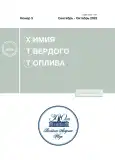Evaluation of Cs-137 Binding by High-Moor Peat in the European North of Russia
- Authors: Orlov A.S.1, Zubov I.N.1, Yakovlev E.Y.1, Bogdanovich N.I.2
-
Affiliations:
- CENTER FOR COMPREHENSIVE STUDY OF THE ARCTIC NAMED AFTER ACADEMICIAN N.P. LAVEROV URAL BRANCH OF THE RUSSIAN ACADEMY OF SCIENCES
- Северный (Арктический) федеральный университет им. М.В. Ломоносова (САФУ)
- Issue: No 5 (2023)
- Pages: 50-54
- Section: Articles
- URL: https://journals.rcsi.science/0023-1177/article/view/232815
- DOI: https://doi.org/10.31857/S0023117723050055
- EDN: https://elibrary.ru/GVDGBN
- ID: 232815
Cite item
Full Text
Abstract
The sorption properties of high-moor peat and products of its sequential disassembly were studied and the binding of Cs-137 by the test materials was evaluated. According to the results of low-temperature nitrogen adsorption, the specific surface area of pores in the test materials varied in a range from 1.48 to 5.96 m2/g, and the total pore volume varied from 0.002 to 0.009 cm3/g. The limiting adsorption of Cs-137 on the test high-moor peat ranged from 1 to 51 Bq/g, which significantly exceeded the background values of
Cs-137 activity determined in the peat deposit and indicated a high sorption capacity of high-moor peatlands with respect to anthropogenic radionuclides. For peat derivatives obtained by the sequential disassembly method, the values of limiting sorption ranged from 2 to 61 Bq/g in the test range of pH. It was revealed that
the pH of the medium and the nature of a sorbent are the key factors determining the efficiency of Cs-137 sorption. It was established that the values of the limiting sorption of Cs-137 for peat and products based on it increased with pH
Keywords
About the authors
A. S. Orlov
CENTER FOR COMPREHENSIVE STUDY OF THE ARCTIC NAMED AFTER ACADEMICIAN N.P. LAVEROV URAL BRANCH OF THE RUSSIAN ACADEMY OF SCIENCES
Email: alseror@yandex.ru
163020 Arkhangelsk, Russia
I. N. Zubov
CENTER FOR COMPREHENSIVE STUDY OF THE ARCTIC NAMED AFTER ACADEMICIAN N.P. LAVEROV URAL BRANCH OF THE RUSSIAN ACADEMY OF SCIENCES
Email: zubov.ivan@fciarctic.ru
163020 Arkhangelsk, Russia
E. Yu. Yakovlev
CENTER FOR COMPREHENSIVE STUDY OF THE ARCTIC NAMED AFTER ACADEMICIAN N.P. LAVEROV URAL BRANCH OF THE RUSSIAN ACADEMY OF SCIENCES
Email: yakov24lev99@mail.ru
163020 Arkhangelsk, Russia
N. I. Bogdanovich
Северный (Арктический) федеральный университет им. М.В. Ломоносова (САФУ)
Author for correspondence.
Email: n.bogdanovich@narfu.ru
Россия, 163002, Архангельск
References
- Schleich B.N., Degering D., Unterricker S. // Radiochim. Acta. 2000. V. 88. P. 803. https://doi.org/10.1524/ract.2000.88.9-11.803
- Savichev O., Soldatova E., Rudmin M., Mazurov A. // Appl. Geochem. 2020. V. 113. № article 104519. P. 243. https://doi.org/10.1016/j.apgeochem.2019.104519
- Gwynn J.P., Dowdall M., Lind B. The radiological environment of Svalbard. Stralevern Rapport 2. Osteras: Norwegian Radiation Protection Authority, 2004. 55 p.
- Dowdall M., Gwynn J.P., Moran C., Davids C., O’Dea J., Lind B. // J. Radioanal. Nucl. Chem. 2005. V. 266. № 2. P. 217. https://doi.org/10.1007/s10967-005-0895-2
- Fiałkiewicz-Kozieł B., Kołaczek P., Piotrowska N., Michczyński A., Łokas E., Wachniew P., Woszczyk M., Sensuła B. // Radiocarbon. 2014. V. 56. № 1. P. 109. https://doi.org/10.2458/56.16467
- Mietelski J.W., Kubica B., Gaca P., Tomankiewicz E., Błażej S., Tuleja-Krysa M., Stobiński M. // J. Radioanal. Nucl. Chem. 2007. V. 275. № 3. P. 523. https://doi.org/10.1007/s10967-007-7026-1
- Mroz T., Łokas E., Kocurek J., Gasiorek M. // J. Environ. Radioact. 2017. V. 175–176. P. 25. https://doi.org/10.1016/j.jenvrad.2017.04.012
- Mihalik J., Bartuskova M., Holgye Z., Jezkova T., Henych O. // J. Environ. Radioact. 2014. V. 134. P. 14. https://doi.org/10.1016/j.jenvrad.2014.02.015
- Hoshino Yu., Komatsuzaki M. // Soil and Tillage Research. 2018. V. 178. P. 179. https://doi.org/10.1016/j.still.2017.12.024
- Милютин В.В., Гелис В.М., Некрасова Н.А., Кононенко О.А., Везенцев А.И., Воловичева Н.А., Королькова С.В. // Радиохимия. 2012. Т. 54. № 1. С. 71. [Radiochemistry, 2012, vol. 54, no 1, p. 75. https://doi.org/10.1134/S1066362212010110]
- Субботин С.Б., Дубасов Ю.В., Коровина О.Ю., Смирнова Е.А. // Радиохимия. 2014. Т. 56. № 5. С. 477. [Radiochemistry, 2014, vol. 56. no. 5, p. 560. https://doi.org/10.1134/S106636221405018X]
- Стрелко В.В., Милютин В.В., Гелис В.М., Псарева Т.С., Журавлев И.З., Шапошникова Т.А., Мильграндт В.Г., Бортун А.И. // Радиохимия. 2015. Т. 57. № 1. С. 64. [Radiochemistry, 2015, vol. 57, no. 1, p. 73. https://doi.org/10.1134/S1066362215010117]
- Воронина А.В., Блинова М.О., Куляева И.О., Санин П.Ю., Семенищев В.С., Афонин Ю.Д. // Радиохимия. 2015. Т. 57. № 5. С. 446. [Radiochemistry, 2015, vol. 57, no. 5, p. 522. https://doi.org/10.1134/S1066362215050124]
- Дубасов Ю.В., Пилютик А.А., Шагин Б.О. // Радиохимия. 2017. Т. 59. № 2. С. 179. [Radiochemistry, 2017, vol. 59, no. 2, p. 203. https://doi.org/10.1134/S1066362217020151]
- Thomson J., Dyer F. M., Croudace I.W. // Geochim. Cosmochim. Acta. 2002. V. 66. № 6. P. 1011. https://doi.org/10.1016/S0016-7037(01)00825-0
- Le Roux G., Marshall W.A. // Mires and Peat. 2011. V 7. № article 08.
- Зубов И.Н., Орлов А.С., Попов А.Н., Пономарева Т.И., Лосюк Г.Н. // ХТТ. 2022. № 5. С. 18. [Solid Fuel Chemistry, 2022, vol. 56, no. 5, p. 330.https://doi.org/10.31857/S002311772205012710.31857/S0023117722050127https://doi.org/10.3103/S0361521922050123]
- ГОСТ 4453-74. Уголь активный осветляющий древесный порошкообразный. Технические условия (Переиздание с изменениями). Дата введения 1976-01-01. М.: Издательство стандартов, 1993. 23 с.
- ГОСТ 6217-74. Уголь активный древесный дробленый. Технические условия (с Изменениями № 1, 2, 3, 4). Дата введения 1976-01-01. М.: ИПК Издательство стандартов, 2003. 8 с.
- Сартаков М.П., Чумак В.А. // Вестник КрасГАУ. 2013. № 8 С. 53. elibrary ID: https://elibrary.ru/item.asp?id=21298306
- Yakovlev E., Orlov A., Kudryavtseva A., Zykov S. // Appl. Sci. 2022. V. 12. № article 10870. P. 142. https://doi.org/10.3390/app122110870











